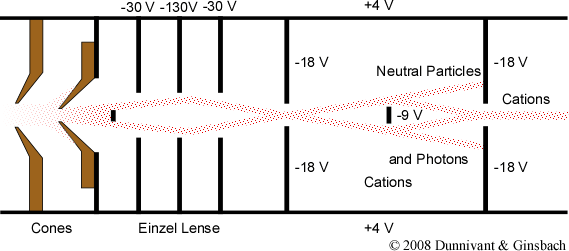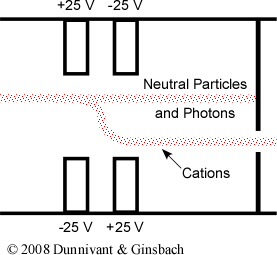4.2.4 Lenses
After entering into the evacuated region, a number of lenses are used to manipulate the path of the ions flowing from the plasma. First and foremost are the accelerator lenses. An accelerator lens consists of two to three plates with a relatively large hole in them (typically larger than the hole in the cones). Each plate has an increasingly negative charge placed across them that result in the attraction of the cations towards the plate increasing their kinetic energy. The hole in the center allows most of the cations to pass directly through the plate. The imposed kinetic energy is needed to pass the cations through the subsequent reaction cell, mass filter, and on to the detector with sufficient energy to dislodge electrons on the surface of the detector (an electron multiplier device).
The next type of lens used in the MS is a focusing lens that centers the cations into a small beam. This lens is used to focus ions into the center of the reaction cell (if present) and the mass filter. One such electrical lens is the Einzel lens that is analogous to a focusing lens in an optical spectrophotometer. An Einzel lens contains six parallel plates, three on each side of a rectangular box, that are exposed to various electric potentials (Figure 4-3). These potentials create an electrical field that bends the cations near the outside of the plates toward the focal point. The lens stretches the length of a given beam of ions since ions on the outside (near the plates) have to travel a longer distance to reach the focal point.

Figure 4-3. Diagram of an Einzel Lens used to focus a beam of ionic particles.
The final class of lenses removes neutral molecules and photons that enter through the cones. Both photons and neutrals are detected by the universal detector that can give false signals and increase the instrumental noise if they are not filtered. Besides causing increased noise, neutrals passing through the mass filter can become adsorbed onto metal components that can interfere with their proper function. There are two major types of lenses that remove neutral particles and photons; a Bessel box and omega lens. A Bessel box, also referred to as a photon stop, is comprised of two photon stops, an Einzel lens, and a set of three lenses (Figure 4-4). The first photon stop (located before the Einzel lense) prevents particles from flowing directly down the evacuated chamber. The Einzel lens focuses the particles into the Bessel box and around the second photon stop. The positive voltage (+4 V) on the outside of the Bessel box and the negative voltage on the second photon stop (-9 V) direct the cations back to the exit slit. Neutral particles and photons are unaffected by the electrical field and are removed.

Figure 4-4. A Bessel Box photon stop.
Another type of lense, an Omega lens, filters out the photons and neutral particles. A cross-section of an Omega lens consists of four electrodes, two near the top and two near the bottom of the ion beam, and is presented in Figure 4-5. The lens works by carefully balancing the charges of the electrodes to deflect the beam of cations, but not the neutral species or the photons from the plasma. This deflection is accomplished by placing a positive charge on the first top electrode and a negative charge on the first bottom electrode that acts to deflect the beam of cations downward in the front of the lens (refer to Figure 4-4). Next the beam needs to be stabilized with respect to the horizontal direction to guide the beam into the reaction cell or mass filter, so an opposite set of electrodes is present, one with a negative charge on the top and one with a positive charge on the bottom. The net result is the deflection of the cations towards the mass analyzer in the absence of particles and photons that continue strait and collide with the end plate. Both the Einzel and Bessel systems are subject to contamination and need to be maintained (usually every six months or so depending on use).

Figure 4-5. An Omega Lens.
| Frank's Homepage |
©Dunnivant & Ginsbach, 2008